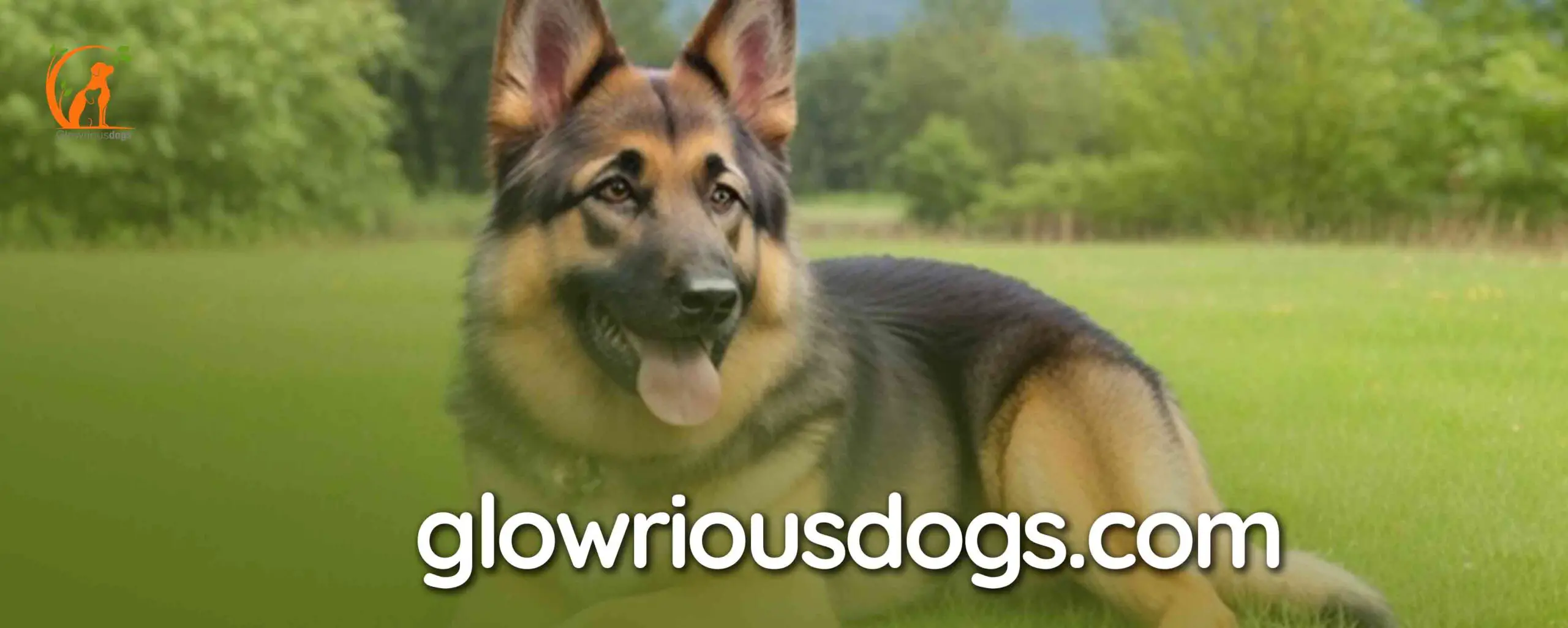A German Shepherd’s dog period typically lasts for about 2-3 weeks. German Shepherds, like other dogs, experience reproductive cycles known as estrus or heat, which is characterized by changes in their behavior and physiology.
During this time, female German Shepherds may exhibit signs such as swollen vulva, increased urination, and a bloody discharge. This is the period when they are fertile and may attract male dogs for mating. It is crucial to keep an eye on your German Shepherd during this time to prevent unwanted pregnancies or manage any discomfort she may experience.
Understanding the duration and symptoms of your dog’s period can aid in providing appropriate care and maintaining her overall health and well-being.
Understanding The Heat Cycle In German Shepherds
The heat cycle in German Shepherds lasts around three weeks and typically occurs twice a year. It is important to understand the duration of dog periods in German Shepherds to properly care for them during this time.
German Shepherds are beautiful, intelligent, and loyal companions, known for their strong work ethic and protective nature. If you’re a proud owner of this remarkable breed, understanding their heat cycle is crucial to their overall health and well-being. Let’s delve into the complexities of the heat cycle in German Shepherds and explore the factors that can affect its duration.
Factors That Affect The Length Of A Dog’S Heat Cycle:
- Age: The age at which a German Shepherd experiences their first heat cycle can influence its duration. Typically, it begins between six months to two years old.
- Hormonal variations: The balance of hormones within a German Shepherd’s body can cause fluctuations in the duration of their heat cycle.
- Genetics: Each dog breed, including German Shepherds, possesses unique genetic characteristics that can affect their heat cycle length.
- Overall health: The general health and well-being of a German Shepherd can impact the duration of their heat cycle. Proper nutrition and regular exercise play a vital role in maintaining a healthy cycle.
- External factors: Environmental factors, such as the presence of male dogs in the vicinity, can influence the length of a German Shepherd’s heat cycle.
Understanding the factors that affect the length of a dog’s heat cycle is essential for any German Shepherd owner. Now, let’s take a closer look at the different stages of their heat cycle to gain a comprehensive understanding.
Overview Of The Different Stages Of The Heat Cycle:
- Proestrus (Approximately 9-12 days): This initial stage marks the beginning of a German Shepherd’s heat cycle. During this time, you may notice some behavioral changes, including increased urination and swollen vulva. Female dogs are not receptive to mating during this phase.
- Estrus (Approximately 9-12 days): The second stage is commonly referred to as the “active heat” cycle. Here, your German Shepherd becomes more receptive to mating, and you may observe a change in their behavior. It is crucial to closely monitor your dog during this time and keep them away from intact males if you’re not planning to breed.
- Diestrus (Approximately 2 months): This is the resting phase of the heat cycle. It is important to note that German Shepherds can experience temporary pregnancy-like symptoms during this period, even if they did not mate.
- Anestrus (Approximately 4-6 months): The final stage is a resting period where the German Shepherd’s reproductive system is inactive. No noticeable symptoms of the heat cycle are present during this time.
Understanding the various stages of a German Shepherd’s heat cycle is vital for their overall health and management. By being knowledgeable about the factors that influence its duration and the behavioral changes that occur during each stage, you’ll be better equipped to provide appropriate care and support for your beloved German Shepherd during this natural process.
Remember, every dog is unique, and their heat cycle may vary slightly. Consulting with a veterinarian is always recommended to ensure the best care for your furry friend.
Identifying The Signs Of A German Shepherd In Heat
German Shepherds in heat typically experience dog periods that last around 2 to 3 weeks. During this time, they may exhibit signs such as swelling of the vulva, increased urination, and changes in behavior and temperament. It is important to be familiar with these signs to effectively manage their heat cycle.
German Shepherds, like all female dogs, go through heat cycles as part of their reproductive cycle. It is important for dog owners to be able to identify when their German Shepherd is in heat to properly handle and care for their furry friend.
In this section, we will discuss the behavioral changes and physical signs to look out for to determine if your German Shepherd is in heat.
Behavioral Changes:
- Increased friendliness and affection towards other dogs or humans: During heat, female German Shepherds might display a more sociable behavior towards both dogs and humans.
- Frequent urination and territory marking: Marking their territory through frequent urination is a common behavior exhibited by German Shepherds in heat.
- Changes in appetite: Some German Shepherds may experience changes in their appetite during their heat cycle. They might show a decreased interest in food or, in some cases, an increased appetite.
- Restlessness and agitation: Restlessness is another behavioral change that can be observed in German Shepherds during heat. They may appear more alert, agitated, or even display pacing or whining behavior.
Physical Signs To Look Out For:
- Swollen or enlarged vulva: One of the most noticeable physical signs of a German Shepherd in heat is a swollen or enlarged vulva. This swelling is a result of hormonal changes and prepares the dog’s body for potential mating.
- Discharge: Female German Shepherds in heat may experience a vaginal discharge. Initially, this discharge is often light in color and consistency, but as the heat cycle progresses, it can become more watery and bloody.
- Frequent licking of the genital area: Increased licking of the genital area is common during a German Shepherd’s heat cycle, as it helps to keep the area clean.
- Changes in behavior during walks: When in heat, German Shepherds may exhibit changes in behavior while on walks. They might display more interest in their surroundings, mark their territory more frequently, or even attract more attention from other dogs.
Understanding these behavioral changes and physical signs can help dog owners determine whether their German Shepherd is in heat. It is important to be aware of these signs to provide the appropriate care and take necessary precautions during this time in your dog’s reproductive cycle.
The Duration Of A German Shepherd’S Heat Cycle
The German Shepherd’s heat cycle typically lasts for about 3 weeks and occurs twice a year. It is important to monitor their behavior and take necessary precautions during this time.
German Shepherds, like all dogs, go through a heat cycle or estrus cycle, which is the period of sexual receptivity when they can potentially become pregnant. Understanding the duration of a German Shepherd’s heat cycle is essential for responsible dog owners.
Let’s take a closer look at the average length of a German Shepherd’s heat cycle and the variations and factors that can affect its duration.
Average Length Of A German Shepherd’S Heat Cycle
On average, the heat cycle in German Shepherds lasts about three weeks. However, it can range from 18 to 24 days. The cycle is divided into four stages: proestrus, estrus, diestrus, and anestrus.
During the proestrus stage, which lasts roughly 7 to 10 days, female German Shepherds experience vaginal bleeding and swelling of the vulva. They may also exhibit increased urination and attract male dogs, although they are not yet ready to mate.
The estrus stage follows the proestrus stage, typically lasting around 5 to 9 days. This is when the female is fertile and receptive to mating. She may display a more flirtatious behavior and actively seek out male dogs.
After estrus comes diestrus, which lasts around 10 to 15 days. If the female has not become pregnant, hormonal changes occur, and she will no longer attract male suitors. During this stage, the dog’s reproductive system prepares for either pregnancy or returning to a non-receptive state.
Finally, anestrus is the resting phase in the heat cycle, lasting approximately 3 to 4 months. During this time, the female German Shepherd’s body rests and recuperates before the next heat cycle begins.
Variations And Factors That Can Affect The Duration
While the average duration of a German Shepherd’s heat cycle falls within the 18 to 24 day range, various factors can influence its length. These factors include:
- Age: Younger German Shepherds may have shorter heat cycles, while older dogs may experience a longer duration.
- Health: The general health and reproductive health of a German Shepherd can impact the length of their heat cycle. Certain underlying health conditions may cause irregularities or prolonged cycles.
- Breed: Different dog breeds can exhibit variations in the length of their heat cycles. While the range mentioned earlier is average for German Shepherds, it’s essential to note that other breeds may have shorter or longer cycles.
- Individual differences: Each German Shepherd is unique, and the length of their heat cycles can vary individually. Some dogs may have consistent cycles, while others may experience irregularities or significant fluctuations in duration.
It’s important to remember that during a dog’s heat cycle, they should be kept away from intact males unless breeding is intended. Providing appropriate care, attention, and monitoring during this period will ensure the well-being of your German Shepherd.
Managing A German Shepherd’S Heat Cycle
The heat cycle of a German Shepherd can vary, but on average, it lasts around three weeks. During this time, it’s crucial to provide proper care and manage their behavior to ensure their comfort and safety.
German Shepherds, like all female dogs, go through a heat cycle which is also known as a “dog period”. Understanding and managing your German Shepherd’s heat cycle is essential for their well-being and your peace of mind. In this section, we will explore strategies for preventing unwanted mating during their heat, tips for keeping your German Shepherd comfortable, and safety precautions to take during this time.
Strategies For Preventing Unwanted Mating During Heat:
- Keep your German Shepherd indoors during their heat cycle to minimize the chances of encountering male dogs.
- Use a secure and sturdy fence in your backyard to prevent any unwanted access from male dogs.
- Walk your German Shepherd on a leash and avoid areas where intact male dogs are known to frequent.
- Consider using doggy diapers or specially designed doggy pants to prevent any accidental matings.
- Utilize hormonal birth control options such as injections or oral medications, but consult your veterinarian before administering any of these methods.
Tips For Keeping Your German Shepherd Comfortable During This Time:
- Provide a quiet and comfortable space for your German Shepherd to rest during their heat. Ensure there are no distractions or disruptions.
- Use cooling mats or pads to help alleviate any discomfort caused by increased body temperature during their cycle.
- Engage in gentle exercises and activities to keep your German Shepherd mentally and physically stimulated without overexertion.
- Offer plenty of fresh water and nutritious meals to support their overall health and well-being.
- Give them extra attention, love, and affection to reassure and comfort them during this potentially stressful time.
Safety Precautions To Take When Your German Shepherd Is In Heat:
- Keep a close eye on your German Shepherd whenever they are outdoors to prevent them from escaping or encountering male dogs.
- Avoid taking your German Shepherd to public places where other dogs frequent, as it increases the risk of unwanted interactions.
- Be vigilant while on walks and maintain a firm grip on their leash to ensure control and prevent any potential confrontations.
- Make sure your German Shepherd always wears proper identification, including a collar with tags or a microchip, in case they become lost during their heat cycle.
- Consult with your veterinarian for further advice on managing your German Shepherd’s heat cycle and to ensure their overall health and safety.
Remember, each German Shepherd is different, and their heat cycle duration can vary. By implementing these strategies, tips, and safety precautions, you can create a safe and comfortable environment for your German Shepherd during this natural phase of their life.
Caring For A German Shepherd During And After The Heat Cycle
Caring for a German Shepherd during and after the heat cycle involves understanding how long dog periods last for this breed, which typically lasts around two to three weeks. Ensuring good hygiene, providing comfort, and monitoring for any abnormal symptoms are essential during this time.
German Shepherds, like many other dog breeds, go through a heat cycle, also known as the estrous cycle or “dog period. ” This is a natural reproductive process that occurs in female dogs and typically happens twice a year. During this time, it’s important for dog owners to provide extra care and attention to their furry companions.
In this blog post, we will explore the topic of caring for a German Shepherd during and after the heat cycle, focusing on proper hygiene and cleaning during the heat cycle, as well as post-heat cycle care including diet, exercise, and rest.
Proper Hygiene And Cleaning During The Heat Cycle:
- Keep your German Shepherd clean and hygienic during this time to prevent any infections or discomfort. Here’s how:
- Regularly clean your dog’s genital area using warm water and a mild dog-specific cleanser to maintain cleanliness.
- Prevent any potential mess and odor by using doggy diapers or disposable pads designed for dogs in heat.
- Avoid using any scented products, such as shampoo or soap, as it may cause irritation or allergic reactions.
Post-Heat Cycle Care Including Diet, Exercise, And Rest:
- After the heat cycle, your German Shepherd may need additional care and attention. Consider the following factors to ensure their well-being:
- Diet:
- Provide a balanced and nutritious diet to support your dog’s recovery. Consult a veterinarian to determine the best food options and portions for your German Shepherd during this time.
- Consider supplements like omega-3 fatty acids to promote healthy skin and coat.
- Exercise:
- Gradually reintroduce exercise to your German Shepherd’s routine, avoiding vigorous activities until your dog has fully recovered. Short and low-impact walks are recommended initially.
- Engage in mental stimulation activities, such as puzzle toys or training sessions, which can help keep your dog mentally active while limiting physical exertion.
- Rest:
- Ensure your German Shepherd gets plenty of rest during the post-heat cycle period. Create a comfortable and quiet space where your dog can relax and rejuvenate.
- Provide your furry friend with a cozy bed or crate to promote restful sleep.
Remember, every German Shepherd is unique, and their heat cycle experience may vary. It’s crucial to keep a close eye on your dog’s behavior and consult with a veterinarian for personalized advice and guidance. With proper care and attention, you can help your German Shepherd navigate this natural reproductive process with ease.
Health Concerns During The Heat Cycle
During the heat cycle, German Shepherds experience health concerns. It is important to know how long their periods last to ensure proper care and attention.
Common Health Issues That May Arise During A German Shepherd’S Heat Cycle
German Shepherds go through a heat cycle, also known as a dog period, which typically occurs every six to seven months. During this time, there are several health concerns that can affect your furry friend. Here are some common issues to be aware of:
- #### Vaginal discharge:
- A dog in heat may experience a bloody discharge from her vulva. This is a normal part of the heat cycle and usually lasts for around 7 to 10 days. However, if the discharge appears excessively heavy or has a foul odor, it may indicate an infection, such as a pyometra, and veterinary attention should be sought.
- #### Increased urination:
- As hormonal changes occur during the heat cycle, your German Shepherd may urinate more frequently. This is a normal response to the body’s physiological adjustments. However, if you notice excessive urination or signs of discomfort while urinating, it could be a sign of a urinary tract infection (UTI) and requires veterinary assessment.
- #### Swollen vulva:
- One of the visible changes during a dog’s heat cycle is the swelling of the vulva. This is a natural occurrence caused by increased blood flow to the area. However, if the swelling appears severe, persists for an extended period, or is accompanied by other concerning symptoms, consulting with a veterinarian is essential.
- #### Behavioral changes:
- During the heat cycle, female German Shepherds may display changes in behavior such as restlessness, increased vocalization, and a heightened interest in male dogs. Additionally, aggression towards other dogs or even their human companions might occur. Proper supervision and management are necessary during this time to prevent any unwanted mating or conflicts.
- #### False pregnancy:
- Some female German Shepherds may experience false pregnancy symptoms after their heat cycle. This can include behaviors such as nesting, weight gain, milk production, and maternal instincts. While this is not a health concern in itself, if the symptoms become excessive or cause distress to your dog, it is wise to consult with a veterinarian for guidance.
Understanding the potential health concerns during your German Shepherd’s heat cycle is essential for their well-being. By recognizing these issues early on, you can ensure prompt veterinary care, if needed, and provide the necessary support to keep your furry friend comfortable throughout this natural process.
Spaying And Neutering Options For German Shepherds
German Shepherds’ dog periods typically last for about two to three weeks. Spaying and neutering options are available to help manage their reproductive cycles effectively.
Discussing The Benefits And Risks Of Spaying Or Neutering
Spaying or neutering your German Shepherd is a significant decision that can have both benefits and risks. It’s important to understand the potential impact on your dog’s health and behavior before making a choice. Here are the key points to consider:
- Prevention of unwanted pregnancies: Spaying a female German Shepherd removes their reproductive organs, eliminating the risk of unplanned litters. Neutering a male German Shepherd reduces their urge to roam and their likelihood of impregnating female dogs.
- Reduction in certain health issues: Spaying your female German Shepherd before her first heat cycle reduces the risk of mammary tumors. Neutering male German Shepherds eliminates the risk of testicular cancer and reduces the likelihood of prostate problems.
- Behavioral benefits: Spaying or neutering can help reduce aggression, territorial marking, and roaming tendencies in German Shepherds. It can also minimize the desire to escape in search of a mate.
- Potential weight gain: Spaying or neutering can lead to an increased appetite and reduced metabolism, potentially causing weight gain if not appropriately managed through diet and exercise.
- Impact on growth and development: Spaying or neutering German Shepherds before they fully mature can affect their growth plates and potentially lead to orthopedic issues, such as hip dysplasia and arthritis.
- Hormonal changes: Spaying or neutering alters hormone levels in German Shepherds, which may affect their overall temperament and behavior. However, it’s important to note that individual variations exist.
Exploring Alternative Options For Managing A Dog’S Heat Cycle
If you’re considering alternatives to spaying or neutering, there are a few options to manage your female German Shepherd’s heat cycle:
- Hormonal medications: Certain medications can suppress the heat cycle in female German Shepherds, alleviating some of the associated challenges. However, it’s crucial to consult with a veterinarian to discuss the potential side effects and long-term implications.
- Protective clothing: Doggy diapers or specially designed pants can help contain the discharge during your German Shepherd’s heat cycle and prevent unwanted mating. This option may need more effort in terms of maintaining cleanliness and hygiene.
- Isolation and supervision: During your female German Shepherd’s heat cycle, you can isolate her from male dogs and closely supervise her activities to prevent accidental mating. However, this method requires constant vigilance and may cause stress to your dog.
Remember, be cautious when considering alternatives to spaying or neutering, as they may not provide the same level of effectiveness in preventing certain health issues or behavioral concerns. Consider consulting with a veterinarian to evaluate the best course of action for your German Shepherd’s specific needs.
Considerations For Breeding German Shepherds
German Shepherds can have dog periods that typically last around 2-3 weeks. It’s important to consider the length of these cycles when breeding German Shepherds to ensure proper timing for successful mating.
Factors To Consider Before Deciding To Breed Your German Shepherd
Breeding a German Shepherd is a significant responsibility that requires careful consideration. Before embarking on the journey of breeding your dog, there are essential factors that you need to weigh. By keeping these considerations in mind, you can ensure that you make an informed and responsible decision.
Here are the key factors to consider:
- Health of the German Shepherd: Breeding should only be done with dogs that are healthy and free from any hereditary or genetic conditions. Consider conducting a thorough health check-up to ensure your dog is in optimal condition.
- Temperament and behavior: It’s crucial to evaluate the temperament and behavior of your German Shepherd. Breeding should only be done with dogs that exhibit desirable traits, including good temperament, intelligence, and trainability.
- Age of the dog: Age plays a vital role in breeding. German Shepherds should reach their maturity before being bred, which is typically around the age of two. Breeding a dog too early or too late can lead to complications.
- Financial considerations: Breeding can be costly, requiring expenses for veterinary care, genetic testing, proper nutrition, and prenatal care for the dog. It’s important to have a realistic understanding of the financial commitment involved in breeding.
- Time commitment: Breeding and raising puppies require a significant time commitment. From finding suitable mates to overseeing the breeding process and caring for the puppies, it’s important to be prepared to dedicate the necessary time and energy.
- Knowledge and experience: Breeding dogs requires a certain level of knowledge and experience. It is advisable to educate yourself on the breeding process, including genetics, reproduction, and whelping. Seeking guidance from experienced breeders can be invaluable.
- Finding a reputable breeder: If you’re considering breeding your German Shepherd, it’s essential to connect with a reputable breeder who shares your values and prioritizes the health and well-being of the breed. A reputable breeder will guide you through the process and provide support.
- Overpopulation concerns: The dog population is already vast, and many dogs end up in shelters or without homes. It’s crucial to consider whether breeding your German Shepherd contributes positively to the breed or adds to the existing overpopulation problem.
- Responsible puppy placement: Breeding comes with the responsibility of finding suitable homes for the puppies. Ensure that you have a plan in place to thoroughly vet potential adopters and provide proper care and guidance in finding forever homes for the puppies.
- Emotional readiness: Breeding can be an emotional journey, filled with both joys and challenges. It’s important to assess your emotional readiness and commitment to the process, as it can be physically and mentally demanding.
Before embarking on the path of breeding your German Shepherd, carefully evaluate these considerations. Responsible breeding practices and finding a reputable breeder are essential to ensure the health and well-being of the breed. By making informed decisions, you can contribute positively to the German Shepherd community and uphold responsible breeding practices.
Conclusion
To summarize, understanding the duration of a dog’s period, particularly for German Shepherds, is crucial for every dog owner. While there is no set timeframe, it typically lasts around three weeks. Recognizing the signs such as swelling, discharge, and changes in behavior, can help you provide the necessary care and support during this time.
Regular vet check-ups and monitoring your dog’s health is essential to ensure there are no underlying issues. Maintaining a clean and hygienic environment, using appropriate dog diapers or pads, and providing extra comfort and attention can help your German Shepherd feel safe and secure during their period.
Remember, each dog is unique, so consult with your vet for personalized advice and guidance. By being knowledgeable and proactive, you can ensure a healthy and happy experience for your German Shepherd throughout their periods.
Frequently Asked Questions On How Long Do Dog Periods Last German Shepherd
How Long Do German Shepherds Bleed On Their Period?
German Shepherds bleed on their period for around two to three weeks.
How Long Does A German Shepherd Period Last?
A German Shepherd’s period usually lasts around 2 to 3 weeks.
How Do German Shepherds Act When In Heat?
German Shepherds in heat may display behavioral changes such as increased restlessness, urine marking, and attracting male dogs.
What Are The 4 Stages Of A Dog In Heat?
The 4 stages of a dog in heat are proestrus, estrus, diestrus, and anestrus.











